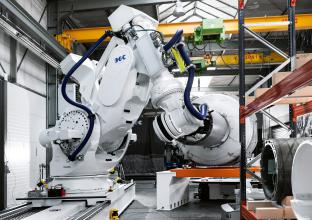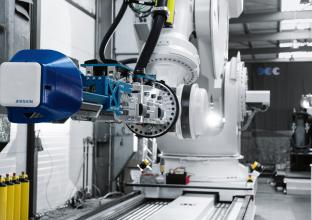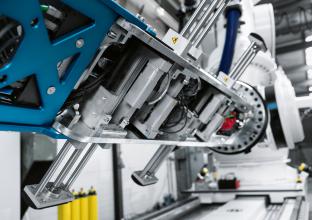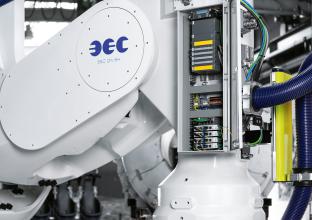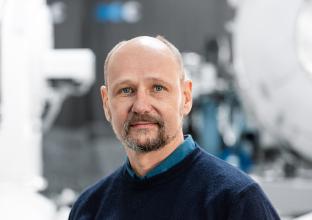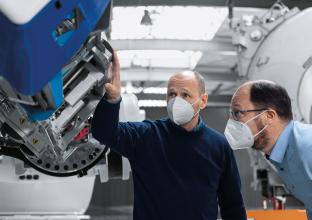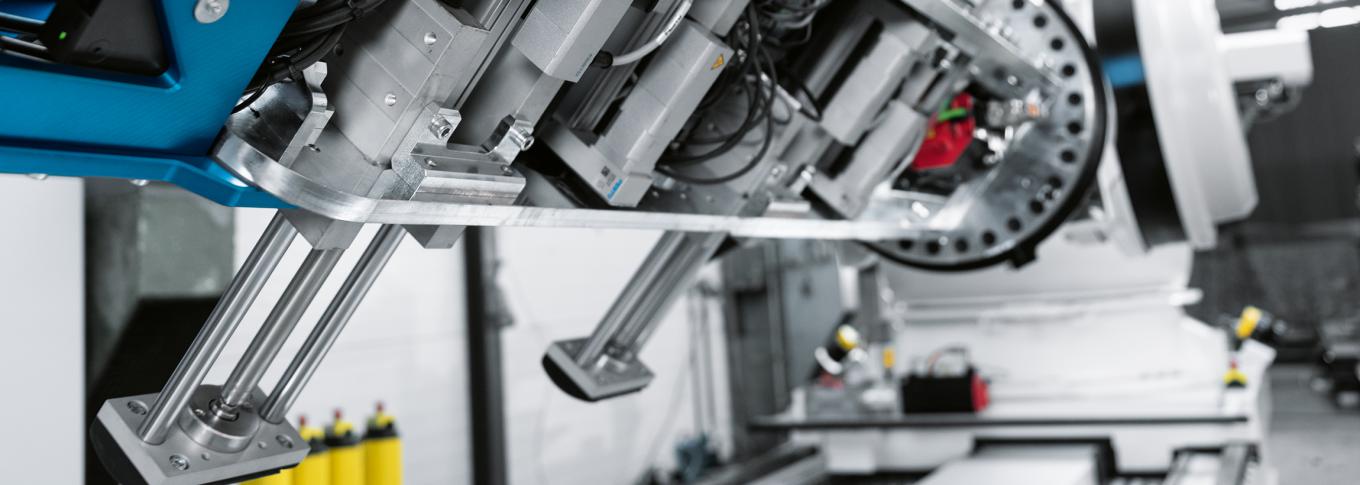
Playing it safe in the assembly of MRI machines
The future belongs to human-robot cooperation. System builder BEC developed such a collaborative solution for Siemens Healthineers. It inserts coils weighing several tonnes precisely into the magnets of magnetic resonance imaging (MRI) machines. Electric cylinders from Festo, which ensure the coils are securely gripped, play a crucial role here.
The first thing you notice when entering the BEC assembly hall is one of the world's biggest articulated arm robots with a load capacity of 2300 kg. It's like something from aerospace technology, and nothing less than high-tech. Even more eye-catching is the vast gripper system, which BEC has mounted on the robot’s articulated arm. Equipped with 3D scanners and touch-sensitive Airskin sensors, it is truly high-tech. “When the gripper picks up the coils weighing up to 1.5 tonnes and inserts them into the magnets of a future magnetic resonance imaging machine, the utmost precision is required,” emphasises Hans-Günther Nusseck, project manager at BEC.
Precise to half a millimetre
Total precision when handling objects weighing 1.5 tonnes might seem like an impossible task, but it’s all part of BEC's core competency. “It is vital that the coils do not twist or slip when the gripper picks them up and inserts them into the magnets; the tolerance for inserting the coils into the magnets is no more than 0.5 millimetres,” explains Nusseck.
This is precisely the task of four supports driven by electric cylinders EPCC from Festo. After entering the coil, the electric cylinders guide the supports against the inner wall of the coil. “The electric cylinders from Festo have proven to be the right choice. They have a compact design, but at the same time provide a large working area and thus have the necessary flexibility for 13 different coil dimensions,” says automation expert Nusseck.
Powerful and gentle at the same time
The supports need to be powerful enough to be able to hold the coils weighing up to 1.5 tonnes, but at the same time not so powerful that they damage them. “The Festo electric cylinders do an excellent job here,” emphasises Nusseck. On a practical note, the drive amplifiers, in this case the servo drives CMMT-ST, are mounted on the robot itself, rather than on the gripper system. “This frees up space on the gripper and makes it less complicated,” reports Nusseck.
Thanks to the compact ball screw drive, the electric cylinder EPCC guarantees quiet operation and precise positioning. Low internal friction ensures short positioning times and a high dynamic response. It is available in four sizes with a non-rotating piston rod, a stroke of up to 500 mm and a plain bearing guide, and includes life-time lubrication for a long service life. The integrated coupling and double bearing make for a compact design. The motor can be mounted in an axial or parallel position, and this can be changed at any time.
The servo drive CMMT-ST has a PROFINET interface for easy integration into existing control systems. “We started working with Festo right from the initial phase of the project to make sure that the drives were designed, sized and commissioned efficiently and matched the overall system,” explains Nusseck.
Free and safe movement in the workspace
Siemens Healthineers uses the system to assemble its MRI machines. It makes the process steps involved in inserting the coils into a magnet significantly safer and more efficient. The real highlight, however, is that the system’s process steps with the articulated arm robot are automated. Thanks to sensor technology with 3D scanners and touch-sensitive Airskin sensors, the system moves freely and safely in the workspace as a collaborative human-robot solution. As a result, there is no need for a safety fence. The role of people consists solely of monitoring this first step in the production of an MRI machine. The sensors in the system ensure safety.
“It is precisely this human-robot cooperation that we consider to be our USP,” explains Nusseck. He also mentions other applications in medical technology where BEC systems are used, such as in radiation therapy for the highly precise positioning of patients at the radiation source, or a robot with seats on an articulated arm that simulates riding a roller-coaster.
About BEC:
BEC is a leading specialist in human-robot cooperation for industry, medical devices and entertainment. With inventive talent and the aim of finding clever solutions, the BEC team develops technically challenging and safety-oriented robotic applications for well-known customers worldwide.
Festo is a global player and an independent family-owned company with headquarters in Esslingen am Neckar, Germany. Festo has set standards in industrial automation technology and technical education ever since its establishment, thereby making a contribution to sustainable development of the environment, the economy and society. The company supplies pneumatic and electrical automation technology to 300,000 customers of factory and process automation in over 35 industries. Digitalization, AI and the LifeTech sector with medical technology and laboratory automation are becoming increasingly important. The products and services are available in 176 countries. With about 20,600 employees in over 250 branch offices in around 60 countries worldwide, Festo achieved a turnover of around €3.45 billion in 2024. More than 8% of this turnover is invested in research and development. In this learning company, 1.5 % of turnover is invested in basic and further training. Festo Didactic SE is a leading provider of technical education and training and offers its customers worldwide comprehensive digital and physical learning solutions in the industrial environment.

